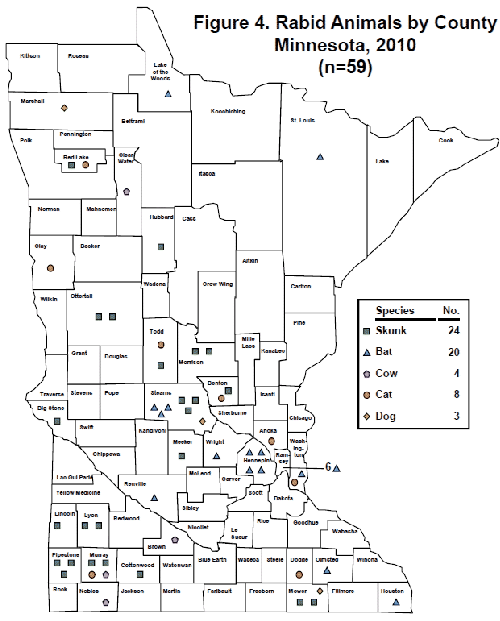Annual Summary of Disease Activity:
Disease Control Newsletter (DCN)
Related Topics
Contact Info
Rabies, 2011
Rabies is caused by the rabies virus, which is highly antigenic, only infects mammals, and has been identified worldwide. In Minnesota, the reservoir species are the skunk and multiple bat species.
In 2011, 55 (2%) of 2,385 animals submitted for testing were positive for rabies (Figure 4). This is similar to 2010, when 59 (2%) of 2,508 animals tested positive. The majority of positive animals in 2011 were bats (28/55 [50%]), followed by skunks (16/55 [30%]), cattle (5/55 [10%]), cats (4/55 [7%]) and dogs (1/55 [2%]). No raccoons or horses tested positive for rabies in 2011 and there were no human cases. The years 2008, 2009, and 2011 are the only ones in which bats have comprised the greatest number of positive animals; all other years the majority of positive animals were skunks.
From 2003 to 2011, 22,069 animals were submitted for rabies testing. The median number of positive animals reported annually was 59 (range, 39 to 94). From 2003 to 2011, 247/512 (48%) skunks, 43/547 (8%) cattle, 189/5,667 (3%) bats, 27/6,209 (0.4%) dogs, 35/7,071 (0.5%) cats, and 0/732 (0%) raccoons that were submitted tested positive for rabies. From 1988 to 2011, 3 raccoons tested positive for rabies; these occurred in 1989, 1990, and 1993.

- For up to date information see>> Rabies
- Full issue>> Annual Summary of Communicable Diseases Reported to the Minnesota Department of Health, 2011